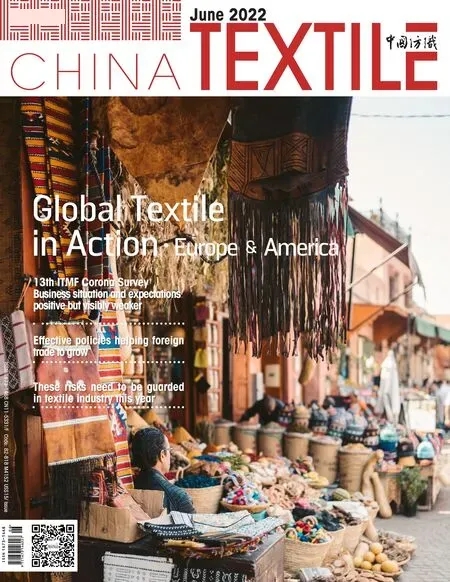Is Italy's textile economy shrinking by half due to ongoing Russia-Ukraine conflict?
By Zhao Xinhua

As a textile power, Italy's fashion industry is highly developed, and the production capacity, export and market share of Italy’s T&C sector occupy an im—portant position in Europe's and even the world’s T&C sector. "Made in Italy" enjoys a worldwide reputation for its excellent quality and innovative spirit, and is in an advantageous position in international competi—tion. Italian textile machinery manufacturing sector is very developed. Data from the Association of Italian Textile Machinery Manufacturers (ACIMIT) showed that the index of orders intake for Italian textile ma—chinery for 2021 stood at 128 points (base 100 in 2015), up 95 percent year—on—year. Foreign orders were up 79 percent year—on—year, while Italian do—mestic orders surged 204 percent. Turkey and China are the most important export markets for Italian textile machinery.
China, still Italy’s biggest source of imports
The total import volume of Italian T&C sector from January to September 2021 was 1,378,434 tons, up 18 percent year—on—year, and the total im—ports were €15.725 billion, down 6 percent year—on—year; the total export volume of Italian T&C sector was 1,124,638 tons, up 17.2 percent year—on—year, and the total exports were €23.492 billion, up 17 percent year—on—year, according to the data released by the Confindustria Moda. Imports and exports are balanced and rising. Of which, From January to September 2021, Italy’s imports from China reached 313,601 tons, up 8.6 percent year—on—year, accounting for 22.8 percent of the total, while its imports reached €3.118 billion, down 42.9 percent year—on—year, accounting for 19.8 percent of the total.
From January to September 2021, Italy's total exports to intra—EU countries reached 641,474 tons, a year—on—year increase of 15.8%; exports to extra—EU countries and regions totaled 483,164 tons, up 19.1% year—on—year; total exports reached 12.041 bil—lion euros, a year—on—year increase of 16.4%. Among them, from January to September 2021, Italy’s exports to Chinese mainland reached 14,005 tons, up 20.9 percent year—on—year, accounting for 1.2 percent of the total, and exports reached €1.298 billion, up 54.2 percent year—on—year, accounting for 5.5 percent of the total. China is the sixth largest exporter to Italy.
At present, Italy is China's fourth largest trad—ing partner in the European Union and China is Italy's largest trading partner in Asia. Sergio Tamborini, chair—man of Camera della Moda, said: "In 2021, France will remain our first trading partner, with a double—digit growth, while China's growth is the most significant in the past two years. Our major export destination countries have already sent a very positive signals. The trade balance of over $ 3.5 billion is undoubtedly encouraging for the whole country, and propelling our manufacturing sector to face the challenges of this period with greater determination.”
Full recovery is uncertain
Russia has been Italy's largest export destination for a long time, and its export products include ready—made clothes, knitwear, underwear and stockings, and semi—finished textiles products. In 2018, Italy's tex—tile and garment exports to Russia exceeded 1 billion euros, which dropped by 17.0% in 2020 following the outbreak. From January to November 2021, exports recovered rapidly, with a total export value of 870 mil—lion euros, an increase of 14.6%. During this period, Italy's exports to Russia accounted for 2.9% of the to—tal exports of this industry, ranking ninth. From January to November 2021, Italy’s exports to Ukraine increased by 19.0 percent to about €166 million, an increase of 5.9 percent compared with the same period in 2019; the apparel sector increased 7.5 percent and the textile sector fell 2.5 percent.
In the first 11 months of 2021, Italy's exports to Russia and Ukraine totaled more than 1 billion euros. However, under the new situation, Italy's economy is affected by the continuous conflict between Russia and Ukraine, and its exports to Russia and Ukraine are severely restricted. According to a report released by the Research Center of the Assolombarda Confin—dustria, the Russia—Ukraine conflict is a key factor that affects the Italian economic trend. It is expected that Italy's economic growth rate will decrease to 1.9% this year from 4% in October last year. In addition, the re—port estimates that due to soaring energy prices, Italian enterprises will spend 5.7 billion euros more on energy every month this year, and about 68 billion euros more on energy throughout the year.
Alessandro Zucchi, president of ACIMIT, said: “We’re experiencing a recovery in the sector that we didn’t quite expect. Production has returned to pre—COVID levels, while foreign demand has been robust in most markets, and in Italy it has benefited from the Government Transition 4.0 incentives.”
Due to the changing global pandemic, many en—terprises in the textile industry have experienced a very difficult two years. Compared with 2020, the cost of elec—tricity in Italy has increased by 470% —650% and the cost of natural gas by 830%. All energy—intensive industries are at risk of rising costs. Faced with the obstruction of transportation of raw materials and record energy prices, Italian enterprises are in a fragile supply chain.
Facing the severe test of the new global situa—tion, the uncertainty of domestic and international markets and the changes of pandemic situation, the overall recovery of the Italian textile and garment industry is still full of unknowns. Italy’s T&C sector has a long way to go to reproduce the former glory of “Made in Italy”.

